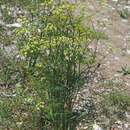en
names in breadcrumbs


Silaum is a genus of flowering plants in the carrot/parsley family, Apiaceae. There are currently ten species placed into the genus, a list of which is provided below.[1]
Plants in the genus Silaum have umbels which are characteristic of plants in the family Apiaceae (they are umbelliferous, "umbel-bearing"); the umbels in Silaus species tend to lack bracts.[2] Silaum species also tend to have a few umbellules (secondary umbels of compound umbels), and these umbellules have several small bracts called bractlets.[2] Remains of dead leaves can often be found at the base of the plant; plants in Silaum are richly branched.[2]
The fruits of Silaum species have a carpophore,[2] a supporting slender stalk for each half of a gape or burst open (dehisced) fruit[3] - these are common throughout the family Apiaceae; the carpophore is thread or filament-shaped (filiform).[2] In addition, Silaum fruits are elongated, divided and not flattened.[2] The mericarps (one carpel of umbelliferous fruit)[4] have acute edges and five, rather low ridges.[2] Plants in Silaus also have an oil tube in the fruit, called a vitta[2][5] - there is one vitta per every ridge of furrow (a vallecula), but are indistinct at maturity.[2] The petals that surround the flowers are yellow.[2]
Silaum was first formally described in 1754 by the Scottish botanist in charge of the Chelsea Physic Garden, Philip Miller; this description was published in his own reference series, The Gardeners Dictionary (abr., ed. 4 (1754)).[2] The etymology of Silaum was not explicitly offered by Miller, who applied a plant name used by Pliny,[6] though it may refer to the mountainous plateau La Sila in southern Italy.[7]
The Global Biodiversity Information Facility (GBIF) lists ten species that are currently placed in the genus Silaum:[1]
Silaum is a genus of flowering plants in the carrot/parsley family, Apiaceae. There are currently ten species placed into the genus, a list of which is provided below.